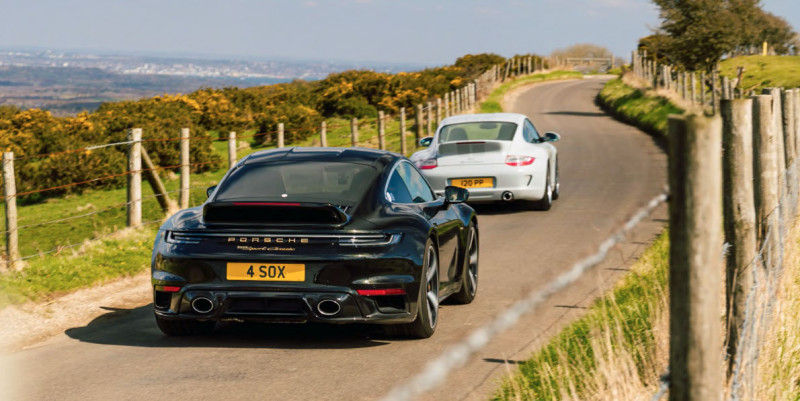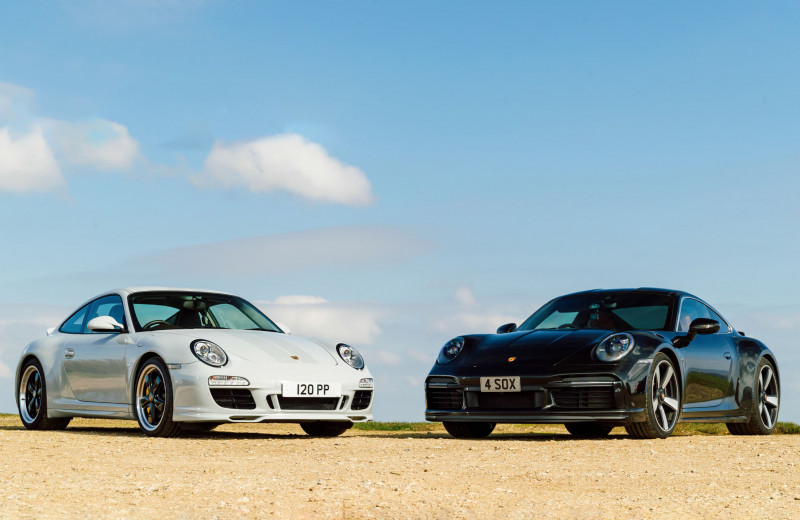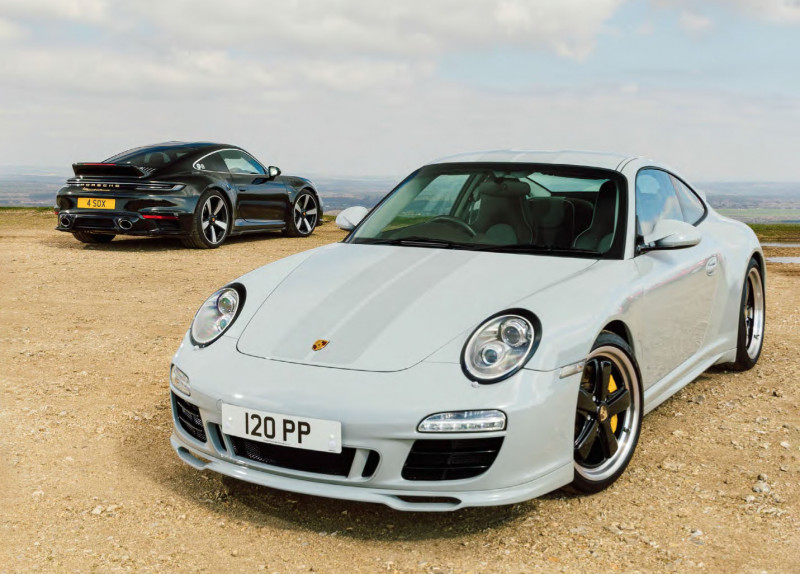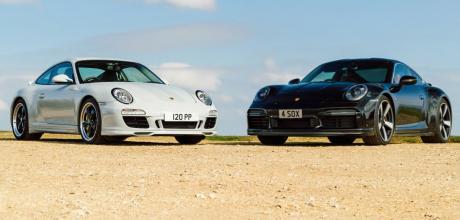2009 Porsche 911 Sport Classic 997.2 vs. 2023 911 992 Sport Classic
It’s the battle of the unicorn 911s as Porsche Exclusive’s 992 Sport Classic squares up to the original from 2009. Which is best?
SPORT CLASSIC 992 vs 997 Sport Classic
Written by Kyle Fortune
Photography by Alisdair Cusick
TWO PORSCHE EXCLUSIVE MASTERPIECES GO HEAD-TO-HEAD: WHICH IS THE ULTIMATE UNICORN 911?
They’re two of the rarest Porsche 911s ever made: which of these Exclusive masterpieces can take the crown as the ultimate Sport Classic?

It’s difficult to comprehend that when the idea of the original 997.2 Sport Classic was first presented, there was uncertainty within Porsche about how receptive the market would be to such a special, limited-series model. Thanks to such lingering doubts, a series of just 250 examples was proposed. That number proved to be conservative – such was the clamour for the Sport Classic, it could have sold many multiples of its tiny production run. The car was conceived partly as a means of communicating a shift in Porsche Exclusive Manufaktur’s business model. It wanted to move from a specialist dream-fulfilment concern – building one-offs and bespoke cars – to that of a division able to produce limited-series models to complement the volume business. The Sport Classic presented a hitherto unseen glimpse into the skill-set of the once-clandestine department, with the car being revealed to the public at the Frankfurt motor show in 2009.

Finished in the exclusive colour of Sport Classic Grey with dark grey decals running from the leading edge of the bonnet and up and over a double-dome roof, it’s a distinctive look that’s instantly recognisable today. Those stripes would continue behind the rear window, over the ducktail spoiler and terminate just above the 911 Sport Classic badge on the rear. Unlike the badges in the series production cars, the letters and numbers under that ducktail were chrome-plated metal rather than metallised plastic, which required Porsche to source them from jewellery suppliers. It’s just one of the many examples of the exacting attention to detail that’s key to the Sport Classic’s desirability.

There are so many of them to take in, which is what I’m doing while Ali’s busy shooting the newest addition to the Sport Classic genre: the 992 Sport Classic. The 997 I’m currently in famously pared the widebody of the C4 or Turbo models with rear-wheel drive and a six-speed manual transmission. The Sport Classic is a feast of visual and technical nods to Porsche’s most significant and revered models. The ducktail is the most obvious one. Porsche’s desire to keep that exclusive means that if you try to order one you’ll need the VIN number of your Sport Classic. The sharkfin rear arch in the same dark grey as the double stripe is a clear link to those commonly seen on 930s, while the black-rimmed headlight bezels are a nod to the 2.1 Turbo RSR from 1974. The Fuchs alloys, with black painted centres and polished rim, need no explanation.

However, that double dome (or double bubble roof) was included as a throwback to the one on the 911 Panamericana concept, as well as the removable roof of the Carrera GT. That roof, which necessitated a worker hand-fitting it to the body on the series production line, is such a significant change to the bodywork that it meant the Sport Classic couldn’t be sold in the US, because it would have needed to first undergo full homologation.
Under that ducktail the 3.8-litre flat six sees its power increase to 408hp at 7,300rpm, with peak torque of 420Nm available from 4,200 to 5,600rpm. The Sport Classic’s engine specification is essentially that of Porsche’s X51 Powerkit. This was an option for the 997.2 that, like Porsche Exclusive Manufaktur itself, wasn’t a widely known possibility for customers at the time. That higher output, naturally aspirated engine drives through a six-speed manual transmission and mechanical limited-slip differential.
Meanwhile, the chassis features PASM with the suspension tuned specifically for the Sport Classic. Getting into the cabin only compounds the notion that the original Sport Classic is very special. Porsche Exclusive Manufaktur’s leatherworkers have managed to cover almost every surface in Espresso brown leather. While that might sound overwhelming, the overall effect is extraordinary. It’s impossible not to marvel at the skill of the people who’ve managed to apply leather so expertly to objects such as the door releases, air vents and around the central PCCM module. The door cards are RS items (with the exterior skins made from aluminium), so the handles sit flat rather than upright. It’s both neater and all the better for exhibiting the glorious woven leather inserts above them.
The same woven leather material is used in the centre seat inserts. There’s light grey Alcantara for the headlining, which both complements and lightens the cabin. That grey also matches some of the contrast stitching on the dash top and steering wheel, as well as the seat piping. The exterior stripe is echoed in both the gearlever and the central rev counter, which is placed in an instrument display featuring metal bezels.
Tempting as it is just to sit inside and decipher the seemingly endless aspects of the Sport Classic’s differences in detail, Paul Pressland, the generous owner of both Sport Classics today, has insisted that they be driven. I’m only too happy to oblige. The overriding memory I have from driving a then-new Sport Classic when it was launched was of its suppleness, its ability to effortlessly smooth out the UK’s horrible tarmac without robbing the car of feel and agility. It wasn’t a false memory, either. How the 997 Sport Classic goes down the road today remains pretty remarkable. It combines comfort with composure and incisiveness, road noise is nicely suppressed, while the steering is light but still imbued with precision and accuracy.
The rim of the steering wheel feels fractionally thicker than those in regular 997.2 Carreras, but it’s quick to turn in, and there’s some real feel at the wheel. The standard fitment of lighter PCCB, which both reduces the unsprung mass while offering repeatable, reassuring stopping power, assist in making the Sport Classic a pleasure to drive. The changes to the engine via the Powerkit are more noticeable on the road than they appear in the stats. There’s an appreciable increase in the midrange, and that flexibility brings easier-gained pace.
The engine’s enthusiasm for revs is still apparent, and it’s so easy to enjoy it thanks to the six-speed manual. The shift is quick and natural, and the clutch’s weighting and feel makes changing gears second nature. There’s a detectable duality here: the Sport Classic initially exhibits an easy, comfortable GT-esque bent, but push through that and there’s a chassis with a real ability, and a responsive, enjoyable powertrain with which to exploit it.
That the Sport Classic essentially created the template for the 997 GTS which followed it is revealing, but while a GTS is serious in its character, the Sport Classic never feels anything less than distinct and very special indeed. Non-GT department 997 perfection? It’s exceptionally close to that. A more rousing exhaust and engine note would help its case, because the civility of the exhaust – a sports system with two promisingly large, chromed tips slung out back – surprises in how muted it is. Apparently, the need for the Sport Classic to pass noise regulations in all the markets it was sold in meant it was pegged back, allegedly to appease the sound police stationed in Singapore. It’s the only negative point (limited availability and huge outlay to acquire one aside) in the Sport Classic’s broad appeal. That, and the fact you could only get it in grey.
That’s something Porsche would change for the car which would revive the now gold-covered badge in 2022, and it would do so in greater, if still limited, numbers. It was always a case of when, rather than if, Porsche would deliver a second Sport Classic. Rumours of it had abounded for years before it was made official, and the sight of the distinctive double dome roof on prototypes prior to that only confirmed what everyone was anticipating. What came as a surprise though, is that instead of being based on the 992 Carrera, Porsche’s new Sport Classic would be spun off the 911 Turbo model line, with Porsche Exclusive Manufaktur building the car in a series of 1,250 examples.
Underlining the paradigm shift that the original Sport Classic was instrumental in introducing at Porsche Exclusive Manufaktur, the new Sport Classic is the second in the intended series of four Heritage Design Edition cars. The Sport Classic’s ducktail references the 2.7 RS, just like the 997 Sport Classic did. Unsurprisingly, it’s very close to its relation in its execution. The 992’s double bubble roof is created with a carbon-fibre panel, and the recess on the similarly bespoke, carbon-fibre bonnet matches the dimensions of the roof indentation. Within that channel there’s the possibility of having a painted stripe, nodding to that decal on the 997.
As is obvious here, Porsche’s second Sport Classic was not only available in grey. Indeed, Porsche gave customers a choice of Sport grey metallic, a slightly darker hue than the 997’s Sport Classic Grey, as well as offering Solid black, Agate grey and Gentian blue from the standard options. There was also a Paint to Sample (PTS) option. Picking PTS denied you the possibility of the painted stripe, but that’s forgivable and understandable when the colour you’ve picked is as considered as the Dark olive green metallic that this car wears.
Being based on the Turbo means the widest body of all 911s, although it’s unique – and not just because of the bonnet, roof and ducktail. The punctured recesses you’ll see in the Turbo and Turbo S have been filled, creating the most abundantly curvaceous rear arches you’ll find on any modern 911. That design choice accentuates the wideness when viewed from the front, or via the wing mirrors, although from the rear the neatly integrated ducktail plays a visual trick of narrowing the 992’s rump slightly. Its height also reduces some of the mass at the 992’s backside – another welcome development. This makes this the most shapely and visually appealing 992 yet, and because there’s no active raising element at speed it’s the neatest on the move, too.
Those wheel arches are filled with forged, centre-locked Fuchs alloy wheels. These have increased from the 19 inches of the 997, to a staggered 20-inch front and 21 inches on the rear for the 992 Sport Classic. It’s not the big things that delight, though. Like the 997 it’s the subtle nods to the past that are so pleasing, from the specification of a classic Porsche shield on the bonnet, the centre of the steering wheel and those centre-locks, to the gold lettering on the badge sitting under the ducktail.
The interior continues that theme, with the Pepita fabric and Classic Cognac semi-aniline leather covering most of the interior, with black leather featuring above the beautiful open pore wood strip with metal trim that dissects the dashboard. Naturally, there are neat features all over the interior, from the classic green-on-black instrumentation to the numbered plaque. However, most pleasingly is what’s situated between the front seats: a seven-speed manual transmission.
That manual gearbox is mated to a 550hp version of the Turbo’s 3.7-litre flat six, making the Sport Classic the first (big T) Turbo model since the 997 GT2 RS to have three pedals and a stick. That’s down on power over the four-wheel drive Turbo and Turbo S, but again, the Sport Classic pushes its power to the rear-wheels only. The loss of drive to the front axle sees a 70kg weight loss, as well as a 40-litre gain in the front luggage compartment capacity. There’s Porsche’s predictably sizeable technical arsenal to give the Sport Classic abundant pace allied with agility, with PASM working with a 10mm dropped sports suspension derived from the Turbo and Carrera GTS, with rear-wheel steering and Porsche Dynamic Chassis Control. The brakes are PCCB items behind those gorgeous centre-lock wheels.
Like the 997, the 992 Sport Classic’s finely curated pick-and-mix specification makes for a compelling whole that’s more than a subtle change. It feels more fundamental and distinct in its execution. The Sport Classic does as its name suggests, adding classic appeal to the driving experience that, somewhat predictably, is centred around the need to drive the car with three pedals and a stick. Yet there’s more depth of character to it then merely that aspect. The chassis exhibits that lovely balance Porsche demonstrated with the 997 Sport Classic, the 992’s suspension taut and controlled, but achieving that with a compliance and comfort that’s genuinely surprising. While a four-wheel drive Turbo S or Turbo is all about shock and awe, confounding at times with its ability to cover ground relentlessly and with a degree of detachment, the Sport Classic requires you to drive it.
Doing so demands a different approach. It’s involving and interesting, with the Sport Classic capable of meting out incredible pace, although how it’s dispatched and used is more down to you, the driver. The engine’s character is subtly different, particularly the torque delivery, with the Sport Classic’s 600Nm peak delivered from 2,000 through to 6,000rpm. That’s 200Nm down on the Turbo S’s peak output, but available over a wider spread of revs. The engine feels keener revving, particularly with the sharper throttle response when switching to Sport, which also brings a most un-Turbo-like rich and rousing soundtrack from the switchable Sports exhaust. The steering feels natural and light, quick to respond with some feel, while those PCCB brakes deliver incredible stopping power with a pedal that’s perfectly positioned to create a platform to roll your foot off it to ease downshifts with a throttle blip. The gearshift’s weighting is beautifully judged, as is the clutch’s. This makes for an immersive driving experience, particularly if you’ve switched off the automatic rev-matching downshift blip, as is possible to do so in all modes.
Naturally, with 550hp to hand there’s the possibility to travel as fast as you dare. The Sport Classic’s pace is relentless when you want it to be, but similarly there’s less requirement to be covering ground quickly to enjoy the experience. Like the 997 there’s a duality to it: the 992 Sport Classic is immersive and interesting to drive regardless of speed, with both cars exhibiting fine balance, huge grip and plentiful traction, with performance to exploit it.
They’ve very close in concept and execution, which is a neat trick from Porsche given the obvious technical differences. It’s also interesting to see just how close the two cars are in relation to the figures. Here the 997 Sport Classic arguably overdelivers, taking 4.6 seconds to reach 62mph and 14.8 seconds to double that at 124mph. The 992 Sport Classic achieves the same in 4.1 seconds and 12.0 seconds.
Not that the numbers matter in any way. In either of its guises the Sport Classic transcends such singular comparison. Instead, the appeal is on a far more multi-faceted and deeper level, which makes them feel very special indeed. Neither could be argued as better than the other. They’re similar enough to be obviously linked and brilliant, but different enough at the same time to be individual.
Just 1,500 of both combined exist, though some of the 997’s magic is apparent in the subsequent GTS, which is an enduring and appealing series model to this day. All of which leaves us wondering whether Porsche shouldn’t do something similar with the Turbo series models. A Turbo T perhaps, as an entry-level, rear-wheel drive manual…?
TOP The 992 Sport Classic’s cabin is a pleasing mix of Pepita fabric, leather and real wood inserts
FAR LEFT Centre-lock Fuchs alloy wheels are fitted on the 992 Sport Classic in a staggered configuration: 20-inch front and 21 inches at the rear
ABOVE The newer Sport Classic’s instrument panel marked a departure from the classic five-dial layout.
“Like the 997 there’s a duality to it: the 992 Sport Classic is immersive and interesting to drive regardless of speed”
TOP Espresso brown leather has been expertly applied to much of the surfaces in the Sport Classic’s cabin
FAR LEFT The 997 Sport Classic is equipped with the lightweight PCCB system for mighty stopping power Metal bezels surround the Sport Classic’s instrument cluster (ABOVE) while contrast stitching adds another dimension to the expert leatherwork (LEFT)
“The Sport Classic never feels anything less than distinct and very special indeed”
ABOVE The 997’s Sport Classic Grey paint scheme is combined with stripes in a darker grey that run from the edge of the bonnet and up and over a double-dome roof


